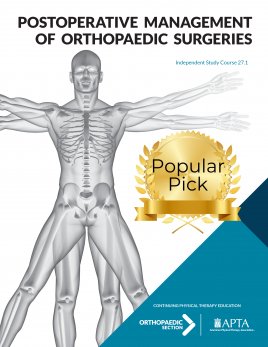
Postoperative Management of Orthopaedic Surgeries
| Online Only | |
|---|---|
| APTA Orthopedics Member | $65 |
| Non-APTA Orthopedics Member | $115 |
Note: CEUs not offered for this course.
Course Description
This 6-monograph course covers postoperative management for injuries and pathology of the hip, knee, ankle/foot, cervical/lumbar spine, shoulder, and elbow. Each monograph addresses the anatomy and biomechanics of the structure, a review of select or common injuries, and nonsurgical and surgical management. Emphasis is placed on rehabilitation guidelines, precautions and contraindications to care, and also expected outcomes.
Course Overview
Course Format: Online
Note
This course is available to you for your enrichment only. Please note, CEUs are not offered for this course.
Course Objectives
- Describe anatomy of the hip joint and how structure can relate to pathological conditions.
- Describe indications for surgical intervention and select surgical procedures of the hip.
- Describe postoperative rehabilitation intervention techniques following hip surgery.
- Know the common structures and pathomechanics involved in knee injury.
- Describe common surgical interventions for patients with knee pathology.
- Describe the physical therapy guidelines, phases, and goals for a patient who has undergone knee surgery.
- Understand the etiology of a calcaneal fracture, Lisfranc fracture/dislocation, and an Achilles tendon rupture.
- Identify the advantages and disadvantages of surgical fixation versus closed treatment for calcaneal fractures.
- Develop appropriate treatment plans for patients who have sustained a calcaneal fracture, Lisfranc fracture/dislocation, or an Achilles tendon rupture.
- Understand specific treatment precautions for patients who have sustained an Achilles tendon rupture.
- Develop an appropriate treatment plan for patients who have sustained a calcaneal fracture.
- Synthesize the current evidence comparing conservative care versus early surgery in different subgroups of patients with cervical and lumbar spine pain.
- Identify the clinical findings that identify patients who are most likely to benefit from cervical or lumbar surgical intervention.
- Compare the different surgical options for treatment of cervical and lumbar pain.
- Describe the benefits of rehabilitation versus no rehabilitation following cervical and lumbar surgery.
- Screen and appropriately manage postoperative complications for presented pathologies.
- Develop an evidence-based rehabilitation program for patients who have undergone different cervical and lumbar surgeries.
- Integrate biomechanics and pathomechanics of the shoulder to evaluation and treatment.
- Implement evidence-based nonoperative treatment strategies for shoulder pathology.
- Describe evidence-based rehabilitation guidelines following shoulder surgery.
- Understand the postoperative precautions associated with shoulder surgery.
- Understand the anatomy and biomechanics of the elbow complex and how it relates to surgical interventions, tissue healing, and treatment.
- Understand postoperative guidelines and treatment progression for the elbow complex.
- Identify the unique precautions and contraindications associated with each of the surgical procedures described for the elbow complex.
- Apply appropriate patient-reported outcome measures for select surgical procedures of the hip, knee, ankle/foot, spine, shoulder, and elbow.
Topics and Authors
- Hip
Keelan Enseki, PT, MS, OCS, SCS, ATC, CSCS; Dave Kohlrieser, PT, DPT, OCS, SCS, CSCS; Craig Mauro, MD; Michaela Kopka, MD, FRCSC; Tom Ellis, MD - Knee
Michael J. Axe, MD; Lynn Synder-Mackler, PT, ScD, FAPTA; Anna Shovestul Grieder, PT, DPT, OCS; Jeff Miller, PT, DPT, OCS, SCS; Melissa Dreger, PT, DPT; Michael Palmer, PT, DPT, OCS; Tara Jo Manal, PT, DPT, OCS, SCS, FAPTA - Ankle and Foot
Stephanie Albin, DPT, OCS, FAAOMPT; Mark Cornwall, PT, PhD, FAPTA; Drew H. VanBoerum, MD - Cervical and Lumbar Spine
Paul Reuteman, PT, DPT, MHS, OCS, ATC - Shoulder
Brittany Lynch, PT, DPT, SCS, OCS; Heather Christain, PT, DPT, SCS, OCS, CSCS; Christopher L. McCrum, MD; Dharmesh Vyas, MD, PhD - Elbow
Julia L. Burlette, PT, DPT, OCS; Amy B. Pomrantz, PT, DPT, OCS, ATC; Chris A. Sebelski, PT, PhD, OCS, CSCS; Justin M. Lantz, PT, DPT, OCS, FAAOMPT; John M. Itamura, MD
Add To Cart
Which version of the course would you like to purchase?
Members Only
You need to be a member to buy this course.
Join today to enjoy exclusive deals and prices on all courses.
Join Now